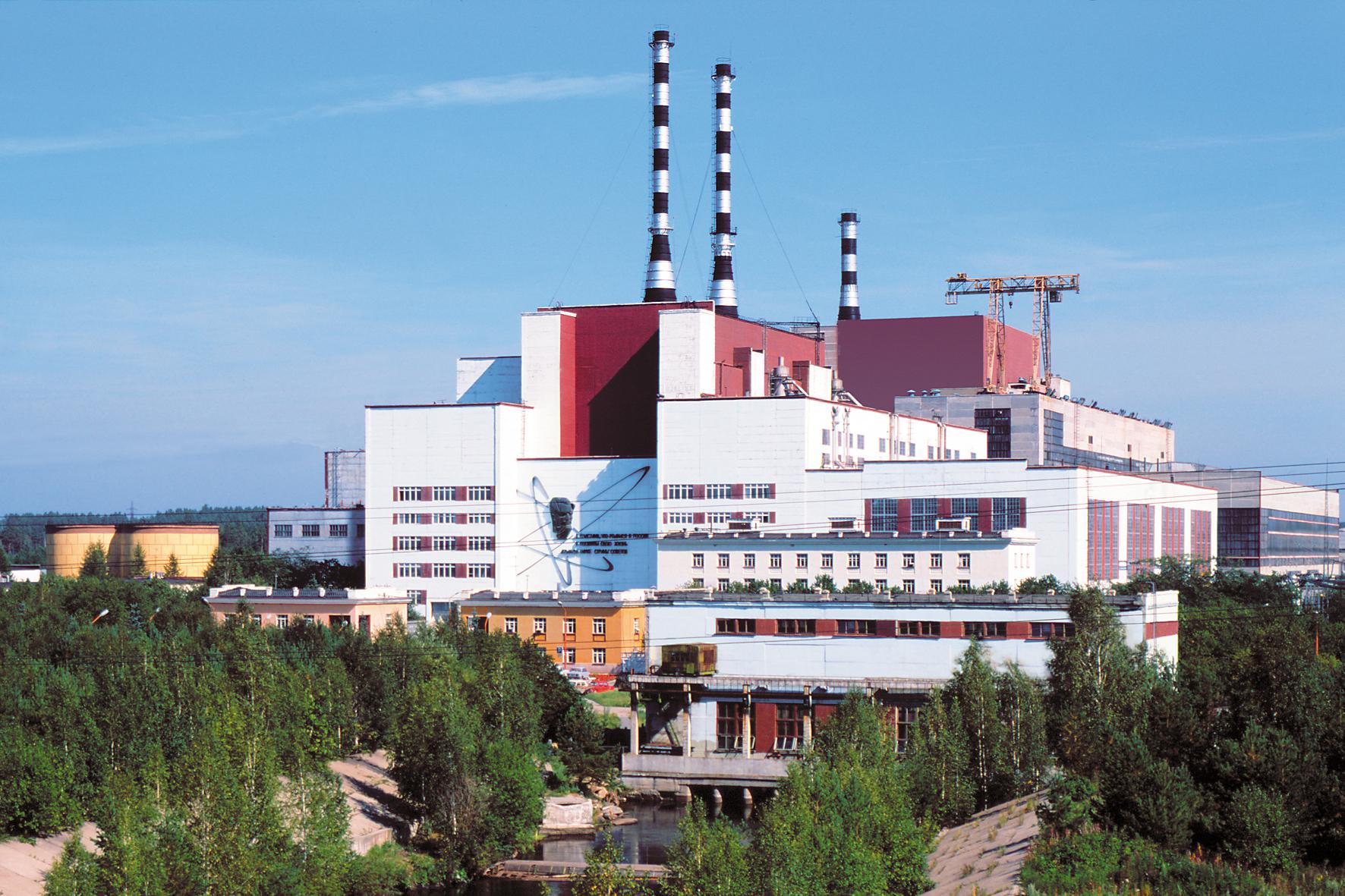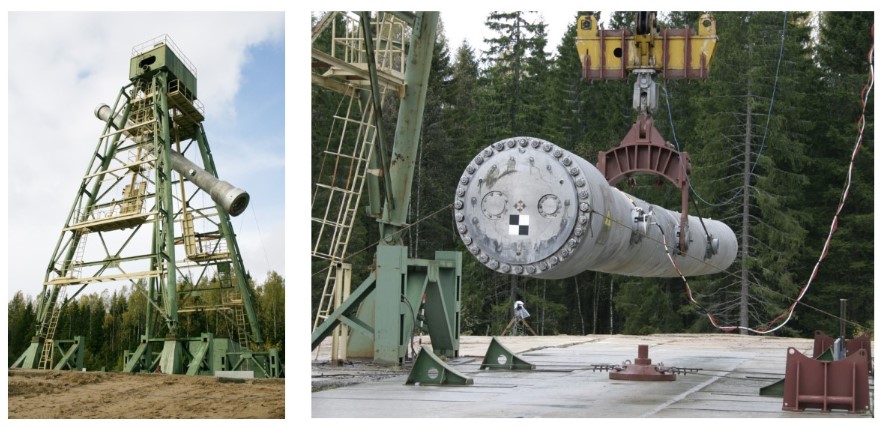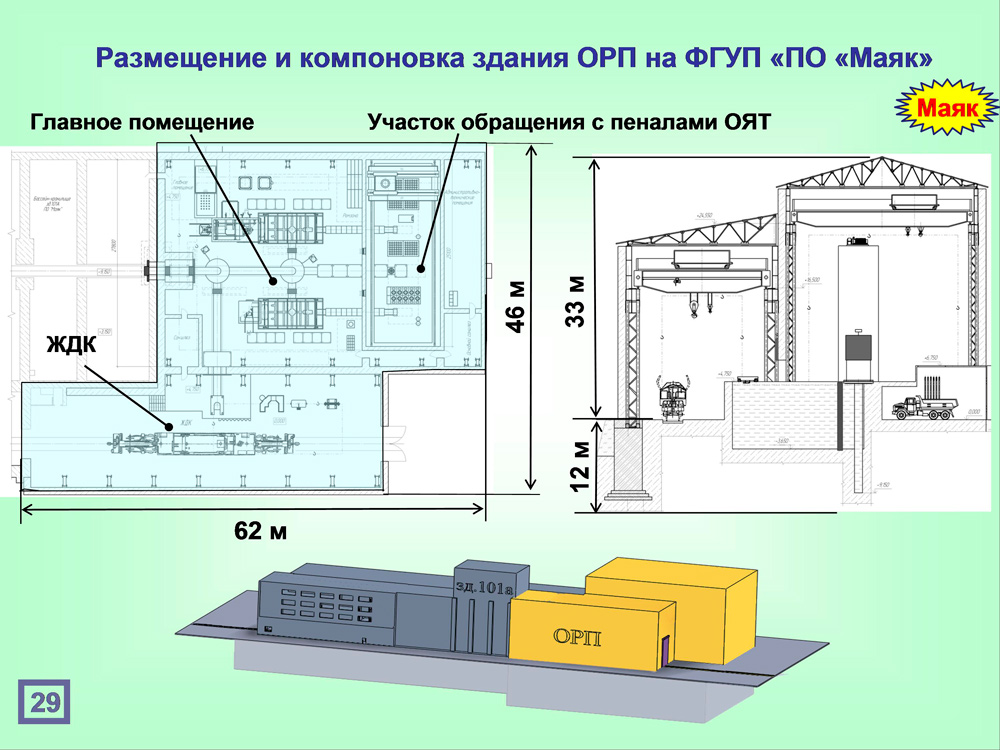
. . .
In 1964, the first-borns of two directions of peaceful nuclear energy started working in the USSR. In September, the first pressurized water reactor VVER-210 was launched at the Novovoronezh NPP. But half a year before it, in April 1964, the AMB-100 water-graphite reactor was put into operation at the Beloyarsk NPP. Thus, the Beloyarsk NPP with an AMB-100 reactor (Atom Peaceful Large) with a capacity of 100 MW became the first peaceful nuclear power plant in the USSR. This reactor no longer produced plutonium for weapons, and the station itself was not located on the territory of the weapons plant. Nevertheless, the design of the reactor was similar to its peaceful (AM) and semi-military (EI and ADE) predecessors - it is a water-graphite channel reactor with tubular fuel elements. The second, twice as powerful, unit with the AMB-200 reactor was put into operation in December 1967.They worked for 17 and 21 years and were stopped in 1984 and 1989, respectively.
About the construction and arrangement of the Beloyarsk NPP in the 1960s, you can watch this documentary - Beloyarsk NPP named after I. In Kurchatova, 1965
In many ways, the work of these reactors was of a research nature, the data obtained on its work served as the basis for the creation of ten times more powerful RBMK reactors, which formed the basis of the Soviet nuclear power industry in the 1970s-1980s.
At the AMB reactors, for the first time on an industrial scale, the scheme of nuclear superheating of steam was tested in order to increase the efficiency (a value of 37% was reached). However, the operation of AMB power units was accompanied by a significant number of deviations and malfunctions. There were also accidents.
So, on May 25, 1976, at the second unit, upon reaching power, after the emergency protection was triggered, several tens of fuel assemblies (FA) were damaged. This accident was one of the most severe in terms of consequences and the restoration work lasted about 9 months.
Beloyarsk NPP today remains special, innovative and experimental - it uses solutions that are new to the industry. Now the world's only industrial power units with fast reactors BN-600 and BN-800 operate here.

The most powerful industrial fast reactor operating in the world is BN-800. Photo by the author.
The first stage of the NPP with AMB units is in the long-term conservation mode. The power units have been finally shut down for more than 30 years, but, according to international standards, they cannot be decommissioned while they have spent fuel. The remaining SNF from them was unloaded into the spent fuel pools, the technological holes in the reactors themselves were closed using a special resin-preservative.

Block control board of the AMB-200 reactor. The control panel is still partially used to control heat supply from the station to the city of Zarechny and to provide for the own needs of BNPP. Photo by the author.
For the complete decommissioning of these units, it is first of all necessary to resolve the issue of spent nuclear fuel (SNF), which has accumulated a little less than 300 tons, and most of which is at the station in an unsatisfactory condition.
The accumulated SNF of AMB reactors belongs to the so-called nuclear legacy of the USSR, to solve the problems of which considerable efforts have been made in recent years.
Features of AMB fuel
One of the main problems associated with why reprocessing or safe storage of AMB spent nuclear fuel was not organized earlier is a wide variety of types of this fuel and its non-standard dimensions. For almost 38 reactor-years of AMB operation, more than 40 types of fuel assemblies (FAs) have been tested for evaporating and superheating channels of reactors.
The fuel assemblies have non-standard dimensions - 14 m in length, which is 4 m more than the fuel assemblies of the largest domestic RBMK reactor. In this case, the fuel was placed only in the central 6 meters, corresponding to the height of the core, and the 4-meter limit switches were filled with pyrographite. The granulated fuel itself was also atypical - it was in the filling material (copper, magnesium or calcium), the mass of which reached 16%. Uranium fuel with an enrichment from 2 to 20% U-235 was divided into several groups in composition - oxide (close to modern uranium dioxide), metal alloy with the addition of 3-9% magnesium, carbide (UC).
During the operation period, 7196 fuel channels were removed from the reactors(about 285 tons of spent nuclear fuel), of which 2227 (about 95 tons of spent nuclear fuel) were sent to the RT-1 plant at PA Mayak, Ozersk, and the rest remained in near-reactor storage facilities at the Beloyarsk NPP until 2016. In the 1970s and 1980s. the possibility of fuel reprocessing at PA Mayak was investigated. The fundamental possibility of organizing the initial stages of the process was shown. But the main problems were associated with cutting the assemblies and preparing them for dissolution. The matter did not come to the practical reprocessing of spent nuclear fuel, so the problem of handling AMB fuel was waiting for its postponed solution.
SNF from AMB was stored at the Beloyarsk NPP in two storage pools in 17- and 35-compartment cassettes (cassettes) and in single cases. 35-seat covers were made of stainless steel, 17-seat covers were made of carbon steel, and were covered with red lead inside and outside before being installed in the pool. Initially, it was planned to store the canisters for a short time in two storage pools, and then send them for radiochemical processing at PA Mayak. But due to the collapse of the USSR, the process dragged on for two decades.
Already in the early 2000s. the biggest problem was fuel in 17-seat cassettes. Most of these cassettes had by that time been in the holding tanks for more than 20 years, which exceeds their design life of 15 years. Therefore, it was assumed that they all lost their tightness and were filled with water from the storage pools. At the same time, they were loaded with irradiated fuel assemblies of earlier and imperfect designs with a significantly higher burnup, as well as almost all damaged fuel. In total, the cassettes contain about 20% of the fuel assemblies damaged during operation. The probable state of the fuel corrosion products is a mixture in the form of a slurry from the corrosion products of the fuel composition components with fragments of graphite bushings. A significant amount of the fuel had a magnesium matrix,which, if the tightness of the fuel element cladding is damaged, is subject to corrosion in water. Fuel may also end up on the bottom of the pool.
At the RT-1 plant of PA Mayak, 131 K-17 cassettes (about 95 tons of spent nuclear fuel) are stored, which were supplied there over 10 years, starting from 1972. The cassettes are placed in the deep-water part of the spent fuel pool. Corrosion-resistant steel cassettes, 103 pcs. and 28 black structural steel cassettes are stored suspended on pool consoles. To prevent corrosion, they are placed in stainless steel cases. The applied method ensures the safe storage of spent nuclear fuel and prevents the pollution of the pool waters by the fission products of spent fuel assemblies, but does not guarantee that problems will not arise in the future that will lead to the destruction of the fuel in the cassettes, as well as the need to abandon the storage of cassettes in a suspended state.
Choice of fuel handling options
Taking into account the complexity of the situation with AMB fuel, a variety of options for handling it were considered: sending for temporary storage with the subsequent resolution of the issue of processing; sending for long-term storage with subsequent burial; cutting and placing in canisters at the NPP itself, and then sending for processing at PA Mayak; delivery of spent fuel assemblies to PA Mayak, cutting and processing.
However, due to the large amount of emergency fuel, its ongoing degradation and due to the high cost of building a modern storage facility for such a quantity of non-standard fuel, it was decided to reprocess AMB SNF at PA Mayak. To do this, it was necessary to take a number of urgent measures to eliminate threats to the safe storage of spent nuclear fuel at the Beloyarsk NPP (for example, since 2001, a water purification system for the spent fuel pool was organized), and at the same time to prepare a solution to two problems - fuel transportation and its further processing at the plant RT-1.
Fuel transportation
For the safe removal of fuel from the BNPP to FSUE PA Mayak, it was necessary to develop a special transport and packaging kit (TUK) for long fuel assemblies with a length of about 14 m and a special container car, to justify the safety of transportation and storage of damaged fuel, as well as to develop handling of long TVS.
As a result, RFNC-VNIITF, together with OJSC Uralkhimmash, by 2006 developed and patentedtwo versions of the TUK-84 transport and packing container for loading 17- and 35-seater cassettes with SNF AMB. The TUK-84 container has a length of more than 15 meters, a diameter of up to 1.4 m. Cassettes with fuel are loaded into a metal sealed container, and it is already placed in a durable container more than 20 cm thick. The TUK is equipped with temperature and pressure control systems inside the container with fuel.

One of the design options for transporting 35-seat cassettes with fuel assemblies. The weight of the container is 86600 kg, the case is 3820 kg and the 35-seat cassette is 9650 kg.
The TUK-84 body is made using a special roll-to-roll technique of “twisted vessel”, when steel strips 5 mm thick and 1.4 m wide are wound and welded into a cylinder of variable thickness. A similar technology is used to create pressure vessels in the chemical industry. Combined with a variable cross-section, it creates a particularly robust housing with minimal weight. As a result, TUK for transportation of long fuel AMB has a mass of less than 90 tons, which allows it to be transported by rail on special wagons without restrictions.

Mechanical drop tests of TUK-84.
By 2014, OJSC Uralkhimmash in Yekaterinburg produced 6 unified TUK-84s, which allow transporting the entire range of casings with AMB fuel stored at the BNPP. The TUK was tested for all types of emergency impact, including a fall from a height of 9 m to a plane and from 1 m to a pin.
The containers are suitable for transportation both by car and by rail. In 2008, six wagon-containers for transportation of TUKs were produced at a carriage plant in Tver.

External view of container wagons for transportation of TUK-84. Its length is more than 28 m. Source .
As a result, in November 2016, the first experimental container car arrived at the Mayak PA, delivering to the radiochemical plant a cassette with SNF from AMB reactors, which was removed from the transport and packaging set and placed in the storage pool of the RT-1 plant. Since October 30, 2017, such deliveries have been carried out on a regular basis in a regular mode. At the end of 2019, the first stage of SNF removal was completed - 124 cassettes with AMB fuel assemblies were removed .
You can see how the fuel is delivered and unloaded in this video from the information center of the Mayak PA.
SNF reprocessing at PA Mayak
Since 1977, the only Russian SNF reprocessing plant RT-1 has been operating at PA Mayak . It processes a wide range of fuel for power and research reactors, icebreaker and submarine nuclear fleet. However, due to its specificity and small batch, the RT-1 never had a line for reprocessing AMB fuel. However, a number of studies carried out previously, showed the fundamental possibility of reprocessing AMB spent nuclear fuel using the technology of the classical PUREKS process with dissolving fuel in acids and separating valuable components (uranium and plutonium), but without "tying" such work to the technology of the RT-1 plant. Studies carried out later showed that this reprocessing is possible on the underutilized second line for reprocessing fuel from fast reactors at RT-1. So there are no fundamental difficulties with the processing itself. However, it is necessary to create infrastructure and workshops for receiving and cutting SNF AMB. For these tasks, PA Mayak is designing a special building for the cutting and penalizing department (ORD) to prepare for reprocessing fuel, both already placed at Mayak, and fuel in cassettes for their further delivery from Beloyarsk NPP.

Cutting and Penalizing Department (ODS) project at FSUE PA Mayak. Source .
Within the framework of FTP NRS-1 (Federal Target Program “Ensuring Nuclear and Radiation Safety for 2008 and for the Period up to 2015”), in 2012, construction of the first stage of the SNF SNF management complex began. Within the framework of the same program, work was financed to create the TUK-84 and the necessary infrastructure at the Beloyarsk NPP itself. In 2015, the first stage of the project for the preparation of the SNF cutting and packing section was completed, including the experimental stand for cutting fuel assemblies and the reconstruction of the spent fuel pool B-4, which allowed starting fuel intake at PA Mayak in 2016.
Experimental stand for cutting fuel assemblies at PA Mayak
At the end of 2019, competitive procedures were played out for completing the second stage of the PIU (“object 630”), worth about 2 billion rubles . Financing of the work is carried out already within the framework of the FTP NRS-2 ( Federal Target Program "Ensuring Nuclear and Radiation Safety for 2016 - 2020 and for the Period until 2030" ). In 2024, it is planned to start reprocessing fuel from AMB-100 and AMB-200 reactors. Until that moment, the already exported fuel will be stored at PA Mayak, and the remaining spent nuclear fuel will be removed in 2026-2027 .
It is worth noting that solving the AMB fuel problem is just one example of nuclear legacy problems in the form of accumulated fuel. In addition to it, many reactor plants have accumulated, albeit small in quantity, but varied due to research work on quality, fuel that has not been previously processed - the fuel of some research reactors, experimental fuel for nuclear submarine reactors. Some of this fuel is defective. In addition, fuel has already accumulated in large quantities for the powerful serial reactors of the NPP - RBMK and VVER-1000.
As part of the elimination of this nuclear legacy, at the RT-1 plant at PA Mayak, not only the second technological line was used for reprocessing spent nuclear fuel from AMB reactors, but in 2016 the reconstruction was completed and the third technological line was put into operation. It can process fuel of several types, including one that has never been processed anywhere before. For example, the first operation on the modernized line was the reprocessing of uranium-beryllium fuel from nuclear submarines. On this line, it became possible to process long SNF, such as VVER-1000, of which more than 6 thousand tons have been accumulated in Russia. As a result of all the planned upgrades, the RT-1 plant at PA Mayak will be able to process almost the entire range of domestic nuclear fuel, both already accumulated and newly formed.

Delivery of spent nuclear fuel from VVER-1000 reactors from Rostov NPP in December 2016. Source .
After the launch of the AMB fuel cutting and processing section at Mayak, the first stage of the Beloyarsk NPP can be finally decommissioned, dismantled and cleaned up for new industrial construction. Thus, the life cycle of the very first reactors of Russian nuclear power plants of industrial capacity should be safely completed.
Used sources:
- Nuclear Legacy Problems and Ways to Solve Them (Volume 1), 2012
- “Removal of spent nuclear fuel from AMB-100 and AMB-200 reactors from Beloyarsk NPP to FSUE PA Mayak. Anfalova O.V. et al. Issues of radiation safety, Issue: 2 (94) year: 2019
- The design of the transport packaging set TUK-84. Atomic Energy (Volume 100, No. 6 (2006)), OV Anfalova and etc.
- Creation of SNF management technologies for AMB of Beloyarsk NPP. Kudryavtsev E.G. Environmental Safety # 1-2010: SNF Management.
- Completion of spent nuclear fuel from AMB and VVER-440 reactors to ensure their joint radiochemical reprocessing at PA Mayak. Kudinov A.S. Dissertation abstract, 2015
- Opportunities and prospects for spent nuclear fuel reprocessing at the RT-1 plant. Presentation of the chief engineer of FSUE PA Mayak D. Kolupaev at the forum "Atomeko-2017".